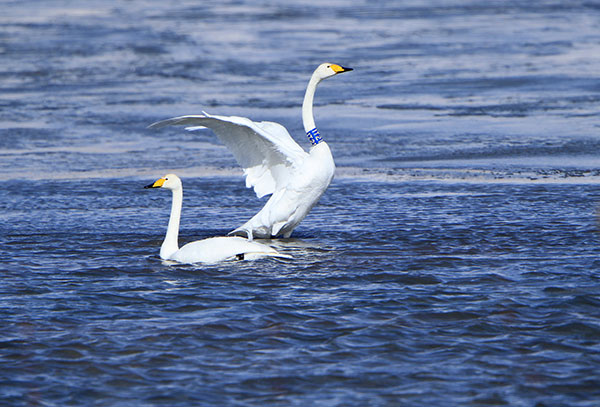Ending wildlife trafficking must be policy priority in Asia
 |
|
A swan with a bird band on its throat at the Gahai Wetland in Gansu province in January, marking the fifth consecutive year it was seen there.[ZHANG YONG/CHINA DAILY] |
This year's World Environment Day on Sunday puts the spotlight on the illegal trade in wildlife. The problem has particular significance in Asia, which is the destination for most of the ivory taken from 20,000 to 25,000 elephants and the horns of more than 1,200 rhinos killed in Africa every year. Demand in the region is driven by fast growing middle and upper classes with an appetite for exotic pets, décor, food and fashion.
While several iconic species including rhinos, tigers and elephants are now in decline, with some populations pushed to the brink of extinction, it is actually less known species such as pangolins, turtles and reptiles that are most frequently smuggled across borders and consumed in the region.
Despite a variety of national and international instruments to counter the problem, transnational criminal groups have been able to circumvent regulations and to mix illegally sourced wildlife into legal markets. This often happens through fraud, advanced smuggling techniques, or more simply corruption. The size of some recent seizures and the variety of nationalities of the couriers arrested leaves no doubt about the organized and transnational nature of wildlife trafficking.
We are paying a heavy price. The illegal wildlife trade undermines our ability to meet the 2030 Sustainable Development Agenda adopted last year. The illegal wildlife trade also has serious negative impacts on biodiversity, leading to the extinction of species and damage to habitat. The environmental impact of the illegal wildlife trade also goes beyond the immediate detrimental effects on target species, and can result in the spread of diseases or introduction of invasive species when live animals are moved across international borders.
-
State wildlife officials remove tigers from Buddhist temple
- Wildlife population expands around Mount Qomolangma
- Ivory burning won't increase price: Kenya wildlife chief
- Wildlife getting better treatment in Jilin






















